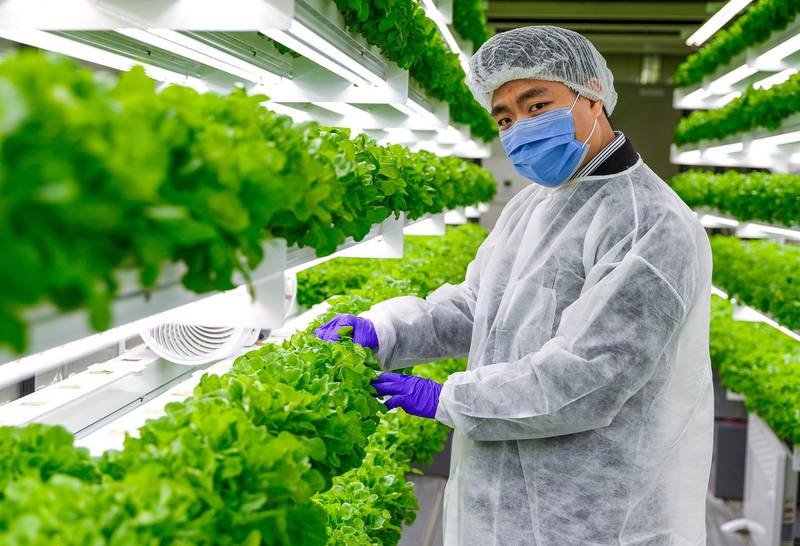Balancing Agricultural Production and Environmental Conservation
What Is Agricultural Sustainability?

Agricultural sustainability seeks to balance food production and the flow of environmental goods. It also recognizes that world population growth is likely to continue for another 40 years, after which it may begin to stabilize or fall owing to changes in fertility patterns.
Sustainable agriculture systems typically have multifunctional roles within landscapes and economies, providing not only food for farmers and markets but also wildlife and habitat, carbon sequestration, water recharge, soil quality and landscape beauty.
Definition
The statutory definition of sustainable agriculture (in the 2018 Farm Bill) states that “an integrated system of plant and animal production practices that over the long-term satisfy human food and fiber needs; enhance environmental quality; increase economic viability of farm operations; efficiently use renewable resources; integrate natural biological processes; and improve farmers’ and society’s overall quality of life.”
In addition to focusing on how to best meet current food and fiber needs, sustainable agriculture seeks to maximize benefits and minimize harms to ecosystem functions beyond a field’s edge. In particular, sustainable farming focuses on maintaining healthy soil that can support crops and other native plants and animals.
This can be achieved by a variety of management techniques, but many are centered around conservation tillage or other strategies that limit cultivation to only what is needed. These methods help keep soil alive and teeming with organisms that promote plant health, prevent erosion and reduce nutrient runoff.
Scope
Sustainable agriculture focuses on meeting human needs without jeopardizing future generations’ ability to do so. It emphasizes stewardship of natural and human resources, and promotes local economies and social justice.
Examples of sustainable farming practices include growing heirloom crops suited to a particular region’s climate, using crop rotation, encouraging the use of fungi that form symbiotic relationships with soil and help plants absorb nutrients, and integrating livestock and crop production to reduce waste. Sustainable farming also relies on natural fertilizers and minimizes the use of chemical pesticides and herbicides.
It reduces environmental problems like water pollution from nutrient runoff and climate change by avoiding excessive irrigation. It reduces health risks like bird flu and Nipah virus by reducing animal crowding and ensuring farm hygiene standards. It bolsters the economy of rural communities by increasing income opportunities and helping them retain control over their land and ecosystem services. It also encourages participation in harvest festivals, which bring together people to celebrate their connection with nature through dance, music and unique dishes.
Challenges
Agriculture is a huge sector that requires substantial change to achieve sustainability. Global population growth, economic development and environmental pressures are placing significant stress on agricultural resources, including natural water, soil and climate. Changing these resources can be expensive, but long-term sustainability depends on balancing tradeoffs.
Some of these tradeoffs include the impact of nutrient cycling, greenhouse gas emissions, habitat fragmentation and water quality. Increasing the efficiency of agricultural practices can reduce these impacts and minimize the need for costly changes.
In addition, it is important to communicate with consumers and farmers about sustainable agriculture. This helps them understand production realities and can build trust in supply chains. Many consumers are willing to pay more for products with sustainability claims like environmentally friendly packaging and ethical sourcing. It is also essential for companies that touch the agricultural supply chain to identify and create incentives for farmers and other supply chain participants to adopt sustainable practices.
Solutions
Some sustainable agriculture methods include soil conservation, water conservation and chemical use reduction. Another solution is to increase biodiversity on farmland, for example through crop rotation and encouraging mycorrhizae fungi (that usually form symbiotic relationships with plants and help them absorb nutrients).
In addition, agricultural sustainability involves stewardship of natural resources. This requires balancing the needs of people in rural communities, the environment and wildlife over long periods of time rather than seeking short-term profits.
For instance, farmers interested in sustainability often prioritize caring for the soil. This involves preventing erosion, preserving the soil’s structure, and improving its quality by increasing organic matter and limiting its pollution through heavy fertilizer use.





